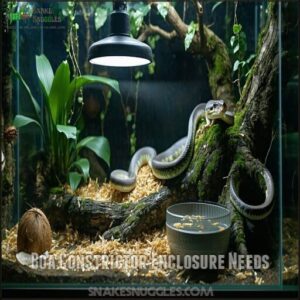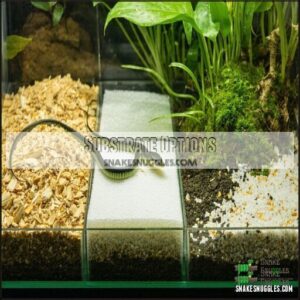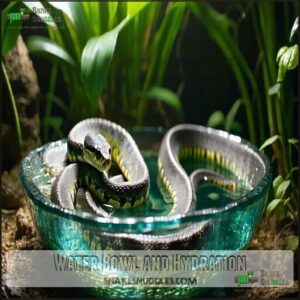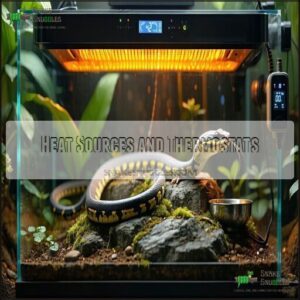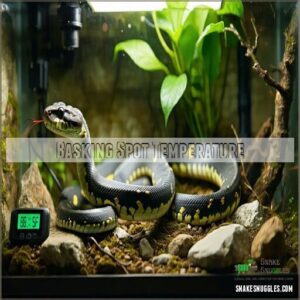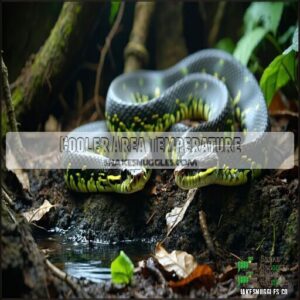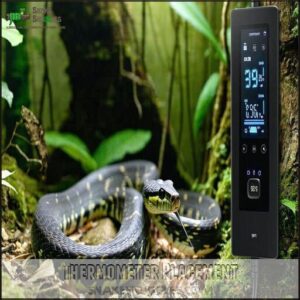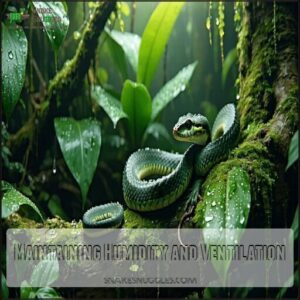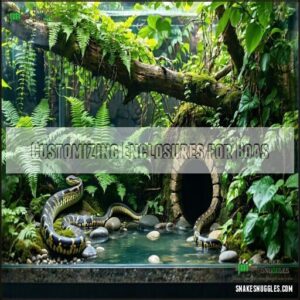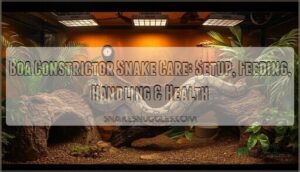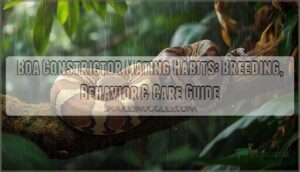This site is supported by our readers. We may earn a commission, at no cost to you, if you purchase through links.
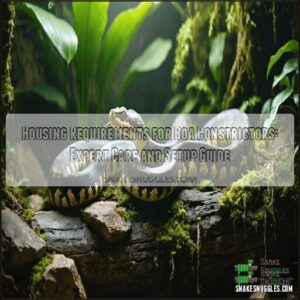 To meet the housing requirements for boa constrictors, start with a sturdy, escape-proof enclosure—at least 6x2x2 feet for an adult.
To meet the housing requirements for boa constrictors, start with a sturdy, escape-proof enclosure—at least 6x2x2 feet for an adult.
Temperature is key. Provide a basking spot around 90-95°F with a cooler area at 80-85°F. Use a heat lamp or ceramic heater, and don’t forget a thermostat to avoid turning your snake’s home into a sauna.
Humidity should stay between 50-70%, so mist lightly and track with a hygrometer. Add a cozy hide, climbing branches, and a water bowl big enough for soaking.
A naturalistic setup isn’t just functional—it keeps things fun for both you and your snake, making for happy herping!
Table Of Contents
- Key Takeaways
- Boa Constrictor Enclosure Needs
- Essential Habitat Components
- Creating Temperature Gradients
- Maintaining Humidity and Ventilation
- Customizing Enclosures for Boas
- Frequently Asked Questions (FAQs)
- What kind of enclosure does a boa constrictor need?
- What do boa need in their habitat?
- What are the housing requirements for snakes?
- How do you house a boa constrictor?
- How often should boa enclosures be cleaned?
- Can boa constrictors be housed with other reptiles?
- What is the ideal feeding schedule for boas?
- Are seasonal temperature adjustments necessary for boas?
- How to safely handle a boa constrictor?
- Conclusion
Key Takeaways
- Keep your boa in a secure enclosure that’s at least 6x2x2 feet, with climbing branches, hides, and a large water bowl.
- Maintain a temperature gradient with a basking spot at 88-95°F and a cooler area between 75-80°F, using thermostats to monitor heat sources.
- Ensure humidity stays at 55-75% by misting daily, offering a large water dish for soaking, and using substrates like cypress mulch or sphagnum moss.
- Clean the enclosure regularly with daily spot cleaning and full substrate replacement every 4-6 weeks to keep your boa healthy and odor-free.
Boa Constrictor Enclosure Needs
Your boa constrictor’s enclosure is its world, so it needs to be safe, spacious, and comfortable.
By getting the size, temperature, and layout just right, you’ll keep your snake happy and healthy (and prevent any Houdini-style escapes!).
Keep your boa cozy, secure, and thriving with the perfect enclosure size, temperature, and setup – no escapes, just comfort!
Temperature Requirements
Boa constrictors rely on a balanced thermal gradient to thrive.
Keep a basking spot at 88-90°F for healthy basking behavior, while cooler areas should stay at 70-75°F.
Night temperatures can drop slightly, but never below 70°F.
A suitable basking bulb is essential for maintaining these temperatures.
Watch for overheating risks with thermostats.
Seasonal variation isn’t essential indoors, but precise reptile temperature requirements guarantee a cozy, comfortable boa constrictor habitat.
Humidity Levels
Humidity plays a key role in your boa constrictor’s health. Aim for 55-75% humidity to prevent dehydration, aid shedding, and avoid respiratory infections.
Monitor levels using a digital hygrometer placed mid-enclosure. Optimal humidity can fluctuate to aid shedding.
- Use damp sphagnum moss in hides.
- Mist daily to keep humidity steady.
- Pick substrates like cypress mulch.
- Offer a large water dish for hydration.
- Avoid extreme humidity fluctuations.
Lighting Needs
Good lighting isn’t just about seeing—it’s a health perk for your boa.
UVB benefits include supporting bone strength and overall well-being. Replace UVB bulbs every six months to maintain their effectiveness.
A steady light cycle, mimicking natural lighting, helps their routine. Investing in proper reptile lighting guarantees your pet thrives.
Snake lighting isn’t optional; it’s indispensable.
Enclosure Size
When planning a boa constrictor enclosure, you’ll want to think big.
A snake enclosure size should allow your boa to fully stretch out.
Use this formula: Boa Length x 0.5 Boa Length x 0.5 Boa Length.
For adults, aim for 6x2x2 feet.
Growth rate matters—start small for young boas but prepare for their larger boa constrictor habitat size, considering the growth rate.
Essential Habitat Components
Your boa constrictor’s habitat needs a few key elements to keep it comfortable, healthy, and stress-free.
From safe substrates to sturdy climbing branches, getting the basics right guarantees your snake feels at home and stays active.
Substrate Options
Choose a boa constrictor substrate that’s safe, easy to clean, and supports burrowing behavior. Options like coco husk or cypress mulch maintain humidity well, while newspaper is budget-friendly but unattractive.
Avoid dusty or ingestible materials for safety. Consider various substrate products for your boa.
Snake substrate should mimic their natural habitat and be replaced frequently to prevent odors or bacteria from taking over your pet’s space.
Decor and Hides
Think of your boa constrictor’s enclosure as their cozy retreat. Add safe decor like branches for climbing enrichment and sturdy rocks for basking.
Provide at least two hiding spots with simple hide boxes or naturalistic designs. Use washable hide materials and clean hides regularly.
Many owners purchase pre-made reptile hides for convenience. A well-designed boa constrictor decor guarantees they feel secure while mimicking their natural habitat.
Water Bowl and Hydration
A sturdy water bowl is key for your boa constrictor enclosure. Choose one big enough for soaking benefits but not easily tipped.
Clean water guarantees proper hydration and aids shedding. Place it on the cooler side to maintain boa constrictor humidity.
For proper moisture control, consider safe substrate materials to help maintain humidity. Monitor water quality often—nobody likes dirty water, not even your snake!
Reliable hydration methods keep them thriving.
Climbing Structures
Your boa constrictor’s arboreal abilities mean climbing structures are a must.
Climbing structures unlock your boa’s natural agility, turning the enclosure into an adventurous haven for exercise and enrichment.
Use natural branches or artificial vines that fit the enclosure size and offer branch stability.
Verify that climbing difficulty matches the snake’s strength, and enclosure height matters—stable, secured branches maximize use.
Avoid flimsy materials; boas are heavy, and climbing structures should be safe, fun, and mimic nature for a happy, healthy snake.
Creating Temperature Gradients
Your boa constrictor’s health depends on a well-maintained temperature gradient, letting it move between warmer and cooler areas as needed.
Think of it like setting up a cozy, snake-sized thermostat—it’s simple with the right tools, and maintaining this environment is crucial for your boa constrictor’s overall health.
Heat Sources and Thermostats
How do you keep your boa snug and safe?
Use heaters like ceramic emitters or heat lamps, but pair them with calibrated thermostats to prevent burns.
Infrared radiation guarantees steady warmth without bright lights.
For temperature consistency, have backup plans during power outages.
Proper heating element safety keeps your boa constrictor enclosure cozy and handles unexpected issues with ease!
Basking Spot Temperature
A proper basking spot keeps your boa healthy and happy.
Aim for an ideal range of 88-95°F, using a reliable heat source like a heat lamp or ceramic heater.
Thermostat control prevents burns, making it a must-have, and monitoring methods like digital thermometers guarantee accuracy.
Remember to check frequently—snakes won’t complain, but their health surely will.
Cooler Area Temperature
How do you create a soothing “cool side” for your boa?
Maintain the cool side temperature between 75-80°F.
It’s key for a proper temperature gradient, letting your snake regulate its body heat.
Nighttime drops? Totally fine for some species.
Here’s a quick visual guide:
| Temperature (°F) | Cool Side Setup | Health Impacts |
|---|---|---|
| 75-80 | Ideal Range | Promotes digestion |
| Below 70 | Too Cold | Risk of illness |
| 80-85 | Slightly Warm | Stressful warmth |
The table outlines the temperature gradient and its effects on the snake’s health, including the risk of illness if the temperature drops below 70°F.
Thermometer Placement
Place digital thermometers at both ends of the enclosure for accurate gradient monitoring. Use probes to track basking areas and cooler zones—key for snake temperature requirements.
Avoid analog thermometers; they’re less reliable. Multi-point monitoring guarantees your boa constrictor’s habitat meets pet temperature requirements.
For burrowing snakes, substrate temperature measurements are also vital. Integrate with a thermostat for safety.
Think of it as creating a cozy, well-regulated snake spa!
Maintaining Humidity and Ventilation
Keeping the right humidity and airflow in your boa’s enclosure isn’t just important—it’s the key to their health and comfort.
You’ll need to strike a balance between moist, clean air and proper ventilation to prevent shedding issues or stuffy conditions.
Humidity Levels and Gauges
Monitoring humidity levels is essential for your boa constrictor’s health, especially during shedding.
Use a digital hygrometer for gauge accuracy and maintain 55-75%. A humid hide with damp moss helps meet pet humidity requirements while preventing shedding issues.
Natural substrates aid in maintaining proper moisture.
Avoid mold by balancing moisture and proper airflow.
Always check snake humidity requirements regularly—it’s a simple way to keep your boa thriving.
Ventilation Options and Holes
Good airflow design is key for your boa’s health.
Add ventilation holes to your snake enclosure type, focusing on balanced hole placement for circulation.
Wood or plastic materials offer breathability but avoid drafts near basking zones.
Good ventilation options prevent mold, control odors, and keep your boa happy.
Remember, every boa constrictor enclosure type needs air to thrive! Breathe easy.
Substrate Moisture and Maintenance
Keep the substrate in your boa constrictor habitat clean and properly maintained.
Spot cleaning daily helps with boa constrictor hygiene, while full replacement every 4-6 weeks prevents mold and mites.
Use the right depth for burrowing behavior, but not so deep it traps moisture.
Regularly check for dampness to maintain the ideal reptile substrate condition and healthy snake habitat hygiene.
Misting and Spraying Schedule
After maintaining substrate moisture, focus on misting frequency.
Use distilled or dechlorinated water to prevent mineral buildup.
Mist daily or as needed to keep humidity levels between 60-75%.
Boost misting during shedding support or seasonal adjustments to avoid dry air.
Don’t soak everything—balance is key.
Over-misting invites mold, so stick to good humidity management for your boa constrictor’s comfort.
Customizing Enclosures for Boas
You’ve got plenty of options for customizing your boa’s enclosure to keep it secure, comfortable, and visually appealing.
From choosing sturdy materials to adding hides and naturalistic decor, it’s all about creating a space your snake can thrive in.
Enclosure Types and Materials
Choosing the right snake enclosure depends on your boa constrictor’s size and needs.
Glass terrariums showcase your pet but are heavy, while plastic cages are lighter but pricier, and wood vivaria offer insulation and security.
PVC enclosures are durable and escape-resistant, and for odd spaces, custom builds shine.
Always match the reptile enclosure type and design with your snake’s behavior and growth.
Security and Escape Prevention
A sturdy boa constrictor enclosure needs secure locks and strong materials to keep your snake safely inside.
Focus on locking mechanisms that withstand force and hinge durability.
Weighing down enclosures adds escape prevention, especially for larger snakes.
Tidy cord management also helps avoid accidental gaps.
With good enclosure design, you’ll turn escape attempts into a snake’s exercise routine!
Visual Barriers and Hides
Blocking out distractions gives boas comfort. Secure hides are essential for their peace of mind.
Place multiple hides in warm and cool areas to let them regulate stress and temperature. DIY hides work great too—it’s not about fancy snake decor, just function!
- Use sturdy hide boxes.
- Try cardboard containers.
- Add natural visual barriers.
- Make certain hide placement suits temperatures.
- Choose safe hide materials!
Naturalistic Environment and Decor
Adding snake decor like branches, natural substrates, and hiding spots creates a naturalistic environment your boa will love.
Use safe decor that’s easy to clean and provides climbing enrichment.
Mix hide variety for visual security, like half logs or plant pots.
Your boa benefits from a relaxing, enriched space – think jungle vibes in their own cozy home!
Frequently Asked Questions (FAQs)
What kind of enclosure does a boa constrictor need?
A boa’s home needs space and security—think at least 6x2x2 feet for adults.
Add hiding spots, sturdy branches for climbing, and temperature control.
Balance warmth, humidity, and safety, making it escape-proof but cozy.
What do boa need in their habitat?
Your boa needs a cozy habitat with temperature gradients, a basking spot, hides, climbing branches, and proper humidity.
Add a large water bowl, safe substrate, and secure enclosure to keep them happy and healthy!
What are the housing requirements for snakes?
Snakes need closures they can’t escape with proper heat, hiding spots, and humidity.
Provide a warm basking area, cooler zone, and clean substrate.
Add sturdy climbing branches and secure locks. Think comfort meets Fort Knox!
How do you house a boa constrictor?
Give your boa a secure, escape-proof enclosure with plenty of space to stretch out.
Provide a temperature gradient, climbing branches, and hiding spots.
Keep humidity levels steady, and don’t skimp on a solid, sturdy lock!
How often should boa enclosures be cleaned?
Clean enclosures weekly to remove waste and spoiled food while spot-cleaning daily.
Deep clean monthly to scrub surfaces and replace substrate.
A tidy setup promotes your boa’s health and avoids odors—plus, they won’t complain about housekeeping, and a tidy setup is essential for their well-being.
Can boa constrictors be housed with other reptiles?
It’s not safe to keep boa constrictors with other reptiles.
They’re strong, solitary hunters and could harm or stress tank mates.
A shared enclosure would feel more like a wrestling match than a home!
What is the ideal feeding schedule for boas?
Imagine feeding a boa every week—like planning a reptile dinner party!
Juveniles eat every 7-10 days, adults every 10-14 days.
Offer appropriately-sized prey, about as wide as the snake’s thickest part.
Are seasonal temperature adjustments necessary for boas?
Yes, seasonal temperature adjustments mimic a boa’s natural habitat, supporting their biological rhythms.
Lower temperatures slightly in winter—around 75°F—but keep humidity stable.
Don’t overdo it; boas aren’t fans of arctic vacations, and maintaining stable conditions is crucial for their well-being, especially in terms of humidity.
How to safely handle a boa constrictor?
Support your boa’s body fully, especially the middle.
Move slowly to avoid startling them.
Keep their head away from your face.
Stay calm—boas sense your energy.
Think of it as holding a strong, curious rope!
Conclusion
Funny how a "simple" setup for a boa constrictor can sound like designing a luxury suite, but your snake deserves it!
By focusing on the housing requirements for boa constrictors—ideal temperatures, humidity, secure enclosures, and enriching decor—you’re setting up a safe, healthy, and engaging environment.
Keep monitoring and tweaking as needed, and soon, you’ll have a happy boa thriving in its perfect setup.
Who knew reptile real estate could be this rewarding? Happy herping!

